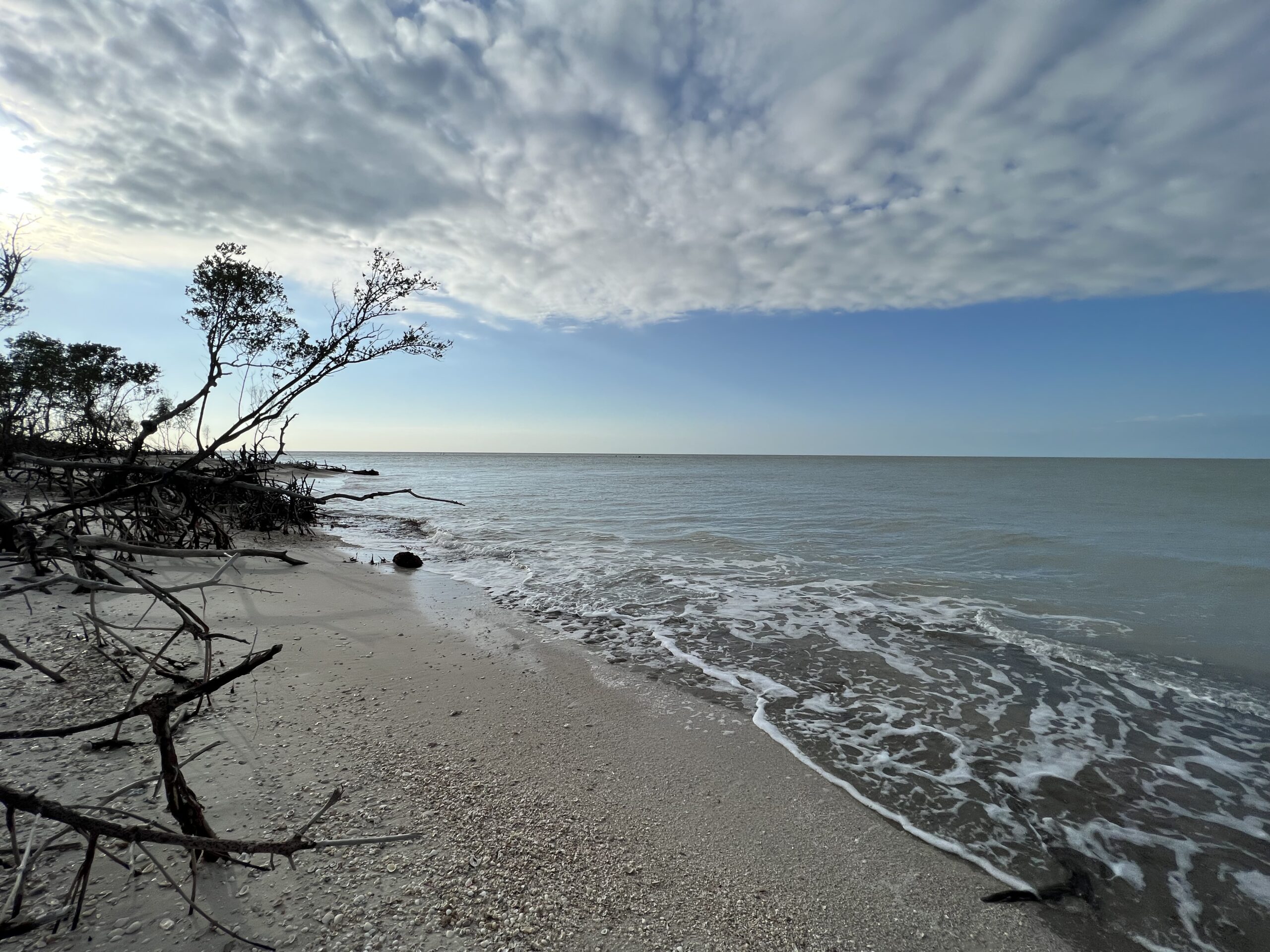Cape Romano Island: Where History and Nature Intertwine
Greetings, fellow adventurers and nature enthusiasts! Embark on a captivating journey through history and nature as we delve into the enchanting realm of Cape Romano Island, a hidden gem nestled within the Ten Thousand Islands National Wildlife Refuge. Prepare to be captivated by the island’s rich heritage, mesmerizing natural beauty, and the delicate balance between preservation and exploration.
A Journey Through Time: Unraveling Cape Romano’s History
Cape Romano Island, a sanctuary of natural wonders, holds a captivating history that intertwines with the Ten Thousand Islands National Wildlife Refuge. Discover the enigmatic tale of the Cape Romano Dome Home, an architectural marvel that once stood as a symbol of human ingenuity amidst the pristine wilderness.
The Cape Romano Dome Home: An Enigma Unveiled
The Cape Romano Dome Home, an architectural masterpiece with a unique story to tell, once graced the island’s shores. Designed by a visionary individual, this dome-shaped structure was built to harmonize with its surroundings, showcasing the potential for sustainable living. While no longer inhabited, the Dome Home’s legacy remains etched into the sands of Cape Romano, a testament to human innovation and respect for nature.
Cape Romano’s Place Among the Ten Thousand Islands
As we explore Cape Romano’s allure, let’s consider its significance within the Ten Thousand Islands National Wildlife Refuge. Situated alongside neighboring islands like Dickmans Island and Kice Island, Cape Romano shares its waters and skies with an abundance of marine life and diverse ecosystems. Together, these islands form an archipelago of unparalleled beauty, a haven for wildlife and a paradise for nature enthusiasts.
Ownership and Preservation: A Delicate Balance
Cape Romano Island has witnessed the passage of time, transitioning through various ownerships. However, the overarching theme remains the preservation of its natural splendor. While the Cape Romano Dome Home was once privately owned, the island itself now falls under the protection of the Ten Thousand Islands National Wildlife Refuge. This sanctuary ensures the island’s unspoiled beauty is cherished and protected for generations to come.
1. Alphabet Cone (Conus spurius)
True to its name, the Alphabet Cone (Conus spurius) is adorned with a series of intricate patterns resembling letters of the alphabet. This fascinating shell, measuring around 1-2 inches in length, is a true masterpiece of nature and a prized possession among shell collectors. Its vibrant hues, ranging from pale yellow to deep orange, add to its allure.
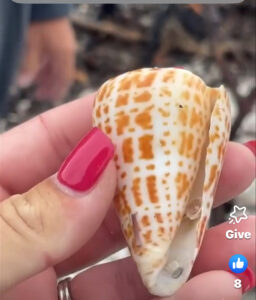
Alphabet Cone (Conus spurius) shell
Identification Tips:
• Look for a cone-shaped shell with a smooth, glossy surface.
• Observe the shell’s pattern, which should resemble letters of the alphabet.
• Notice the shell’s coloration, which can vary from pale yellow to deep orange.
Learn more about Alphabet Cones:
Alphabet Cones; One-of-a-Kind Shells
2. Lightning Whelk (Busycon contrarium)
The Lightning Whelk (Busycon contrarium) is a large, imposing shell that can reach up to 8 inches in length. With its distinctive spiral pattern and pronounced nodules, this shell resembles a lightning bolt, hence its name. The Lightning Whelk is a carnivorous predator, playing a crucial role in the marine ecosystem.
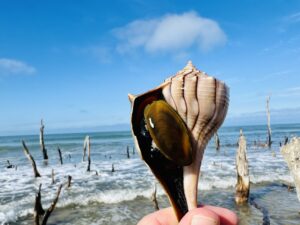
Lightning Whelk (Busycon contrarium) shell
Identification Tips:
• Look for a large, heavy shell with a spiral pattern.
• Observe the shell’s nodules, which are pronounced bumps along the spiral ridges.
• Notice the shell’s coloration, which can be white, gray, or brown.
3. Lettered Olive (Oliva sayana)
The Lettered Olive (Oliva sayana) is a delicate, cylindrical shell that measures around 1-2 inches in length. Its smooth, glossy surface is adorned with a series of intricate markings that resemble letters, hence its name. The Lettered Olive is a scavenger, feeding on dead or decaying organic matter.
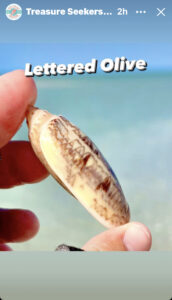
Lettered Olive (Oliva sayana) shell
Identification Tips:
• Look for a cylindrical shell with a smooth, glossy surface.
• Observe the shell’s markings, which resemble letters or hieroglyphics.
• Notice the shell’s coloration, which can be white, yellow, or orange.
4. Junonia (Junonia emarginata)
The Junonia (Junonia emarginata) is a rare and highly sought-after shell among collectors. Its distinctive shape, resembling a miniature helmet, and its vibrant coloration, ranging from orange to pink, make it a true gem of the sea. The Junonia is a carnivorous predator, feeding on small invertebrates.
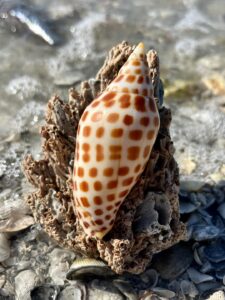
Junonia (Junonia emarginata) shell
Identification Tips:
• Look for a helmet-shaped shell with a smooth, glossy surface.
• Observe the shell’s coloration, which can range from orange to pink.
• Notice the shell’s aperture, which is narrow and has a distinct lip.
Learn more about the Junonia:
What is a Junonia shell?
5. Scotch Bonnet (Drupa nodulosa)
The Scotch Bonnet (Drupa nodulosa) is a large, heavy shell that can reach up to 3 inches in length. Its distinctive shape, resembling a bonnet, and its pronounced spikes give it a fierce appearance. The Scotch Bonnet is a carnivorous predator, feeding on crustaceans and other mollusks.
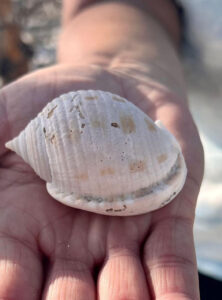
Scotch Bonnet (Drupa nodulosa) shell
Identification Tips:
• Look for a large, heavy shell with a bonnet-like shape.
• Observe the shell’s spikes, which are pronounced and pointed.
• Notice the shell’s coloration, which can be white, gray, or brown.
Additional Tips for Identifying Shells on Cape Romano Island:
• Consult a shell identification guide or app for detailed descriptions and images.
• Pay attention to the shell’s size, shape, color, and markings.
• Observe the shell’s habitat, as certain shells are more likely to be found in specific areas.
• If you’re unsure about a shell’s identity, ask a knowledgeable shell expert.
Learn more about the Scotch Bonnet:
The Enchanting World of Scotch Bonnet Shells Nature’s Masterpieces
The Cape Romano Experience: A Tapestry of History and Nature
A stroll along the shores of Cape Romano Island is akin to a journey through time, where the echoes of history resonate with the rhythms of the sea. The mysteries of the Dome Home, the island’s place in the archipelago, and the ethereal Alphabet Cone – these elements converge to create an unforgettable experience, a harmonious blend of human ingenuity and natural wonders.
Preserving Cape Romano’s Legacy for Future Generations
As modern-day explorers, we have the privilege of experiencing Cape Romano’s beauty. Let us honor this privilege by leaving no trace of our visit, allowing the island’s charm to continue enchanting future generations. Let us tread lightly, respecting the delicate balance between exploration and preservation, ensuring that Cape Romano’s legacy remains intact for all to cherish.
Embark on Your Cape Romano Adventure
From the intriguing history of the Dome Home to the mesmerizing Alphabet Cone, Cape Romano Island offers an immersive journey where nature and history intertwine. It’s an invitation to explore, appreciate, and safeguard the essence of a place that captures both the heart and imagination. Discover the captivating tale of Cape Romano Island, a timeless destination where history and nature weave a tapestry of wonder.
#CapeRomanoTales #HistoryAndNature #IslandWonders #PreservingParadise #DomeHomeLegacy #UnearthedTreasures #TreasureSeekersShellTours
